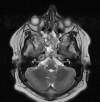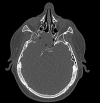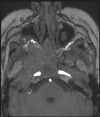Clinical Characteristics of Recurrent Juvenile Nasopharyngeal Angiofibroma (JNA) After Radiation Therapy
- PMID: 26693464
- PMCID: PMC4678271
- DOI: 10.1007/s12070-015-0861-4
Clinical Characteristics of Recurrent Juvenile Nasopharyngeal Angiofibroma (JNA) After Radiation Therapy
Abstract
Juvenile nasopharyngeal angiofibroma (JNA) is a benign vascular tumor occurring in young males. Treatment of JNA is a complex procedure, especially in advanced cases with a high risk of major complications. We report the clinical, radiological and histological specialties of a rare case of recurrent JNA 3 years after radiation therapy in an 18-year-old boy. The patient underwent endoscopy assisted partial midfacial degloving approach. This treatment has been shown to be effective in advanced JNAs with minor morbidity.
Keywords: Midfacial degloving; Radiation therapy; Recurrent juvenile nasopharyngeal angiofibroma.
Figures
Similar articles
-
Stage III nasopharyngeal angiofibroma: Improving results with endoscopic-assisted midfacial degloving and modification to the Fisch staging system.J Craniomaxillofac Surg. 2015 Oct;43(8):1678-83. doi: 10.1016/j.jcms.2015.07.025. Epub 2015 Jul 31. J Craniomaxillofac Surg. 2015. PMID: 26302935
-
Juvenile nasopharyngeal angiofibroma: analysis of 42 cases and important aspects of endoscopic approach.Int J Pediatr Otorhinolaryngol. 2009 Mar;73(3):401-8. doi: 10.1016/j.ijporl.2008.11.005. Epub 2009 Jan 4. Int J Pediatr Otorhinolaryngol. 2009. PMID: 19124161
-
Endoscopic graduated multiangle, multicorridor resection of juvenile nasopharyngeal angiofibroma: an individualized, tailored, multicorridor skull base approach.J Neurosurg. 2016 May;124(5):1328-38. doi: 10.3171/2014.12.JNS141696. Epub 2015 Nov 13. J Neurosurg. 2016. PMID: 26566205
-
[Primary juvenile nasal angiofibroma in a 38 year-old male (case report)].Vestn Otorinolaringol. 2019;84(5):76-80. doi: 10.17116/otorino20198405176. Vestn Otorinolaringol. 2019. PMID: 31793532 Review. Russian.
-
Advanced craniofacial juvenile nasopharyngeal angiofibroma. Description of surgical series, case report, and review of literature.Acta Neurochir (Wien). 2011 Mar;153(3):499-508. doi: 10.1007/s00701-010-0922-0. Epub 2011 Jan 28. Acta Neurochir (Wien). 2011. PMID: 21274578 Review.
References
-
- Lund VJ, Stammberger H, Nicolai P, Castelnuovo P, Beal T, Beham A, et al. European position paper on endoscopic management of tumours of the nose, paranasal sinuses and skull base. Rhinol Suppl. 2010;22:1–143. - PubMed
Publication types
LinkOut - more resources
Full Text Sources
Other Literature Sources





